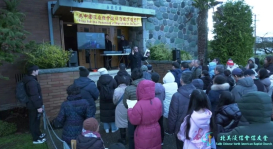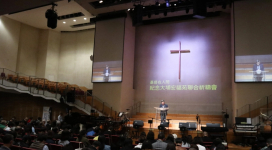The Chinese church is experiencing a new wave in missions today. In Southeast Asia, some Chinese churches took the lead in developing mission programs in the late 1960s. In North America, the current interest in missions is built on the foundation of the student Bible study groups in the 1960s and 1970s, which evolved into Chinese churches by the 1980s. In the 1990s many of these Chinese churches have developed mission budgets, convene annual mission conferences, are sending short-term teams for missionary service and exposure, and are calling upon Christians to consider long-term careers in missions. Chinese Christians today are going to Israel, Russia, Belize, New Zealand, Northern Thailand, Brazil and Guam to reach their fellow Chinese for Christ. Result: Chinese churches are being planted around the globe. The CCCOWE movement of Chinese Christians and churches, already very diverse with different languages and dialects spoken and 2nd and 3rd generation ethnic Chinese Christians in their ranks, will become even more diverse, complex, and exciting.
Chinese Christians have inherited the “pioneer missions” spirit from western evangelical missionaries. Consciously or unconsciously, we believe that the primary, if not the sole purpose for the existence of the church of Jesus Christ on earth is to preach the gospel and reach the lost. “Church” and “mission” are identical. This popular understanding of the purpose of the church has its own historic roots: not so long ago, the Chinese church was a mission field. We have evolved from depending on western missionaries to self-government and self-support. It was only in the 1970s, for example, that Hong Kong’s seminaries became truly indigenous in their governance. (Most Chinese seminaries in North America were founded in the 1980s and 1990s.) The Chinese church has not had a long history in growing unto maturity. We have been busy reaching our fellow Chinese wherever they migrate, planting churches, finding pastors, building sanctuaries, trying to hold on to our 2nd generation young people, and starting mission budgets.
In this process, the Chinese church has inherited a unique trait from some of our western missionary friends: the lack of church consciousness. This has become part of the Chinese evangelical tradition. We are more aware of the need to preach the gospel, than to grow our churches into biblical, Christ-like maturity. We are more aware of direct evangelism than planting churches which are self-governing and self-propagating. We are more aware of immediate needs of discipleship, than long term needs of developing leadership – nurturing tomorrow’s pastors, missionaries, theologians, counselors, youth workers, musicians, and artists. In short, we tend to have a short-term and partial understanding of what God has called the church to be and to do in the world. We are more aware of the church as an organism – the body of Christ – than the church as an organization – an institution in society and history, with its unique role as witness, salt and light.
ROOTS OF A WEAK CHURCH CONSCIOUSNESS
This confusion between “church” and “mission” has its historic roots, beyond the fact that the Chinese church is relatively young. We shall seek to gain an understanding through looking back at developments in the late 19th and early 20th centuries.
When Protestant missionaries went to China, in large numbers after 1860, they were sent by numerous denominations and independent “mission societies.” In the late 19th and early 20th century, most western Christians assumed that different churches largely agreed on what Christians believe; they only differed in secondary matters. As a matter of fact the word “denomination” assumed a larger “church of Jesus Christ,” of which denominations were subsets, smaller entities of a larger whole. Thus when the revival of the 1860s (led by Dwight L. Moody and others) reaped the fruit of student volunteers for missions (the Student Volunteer Movement for Foreign Missions was founded in 1883), it was a natural development that dozens of denominations and mission societies began to send workers to the field – China being the largest field at that time. Cooperation between churches and mission societies was assumed to be the ideal. Everyone believed in cooperation. Reality, however, became quite a different matter.
Throughout the latter part of the 20th century, missionaries had felt the need to cooperate with one another. Interdenominational missions conferences were held in New York and London. This culminated in the International Missionary Conference, held in Edinburgh, Scotland, 1910. In order to include as many denominations and mission agencies as possible, the conference leaders (John R. Mott being the prime mover) agreed that the conference would not discuss the doctrinal matter of “creeds,” and that “who is a Christian” was a matter left to the individual churches. This compromise measure was taken so that the Anglican bishops in England would agree to support the conference. This move had long term consequences. Missionaries continued their interest in cooperation, and continued their relative negligence of doctrinal matters, including the doctrine of the church.
Out of great zeal to convert Chinese to Jesus Christ, the size of the missionary force in China grew rapidly. By the early 20th century, it was felt that concrete steps must be taken to encourage cooperation. Several models emerged: (a) cooperative efforts, such as joint Christian colleges such as Yenching University and hospitals such as Beijing Union Medical College; (b) comity, where mission societies were assigned specific geographical boundaries for evangelism and church planting; (c) federation, or the effort for mission societies to come together in a loose structure; and (d) rare occasions when missionaries from various denominations gave up their own identities, and merged into an indigenous union church. John Mott toured China in 1912 and 1913, and established the China Continuation Committee (to continue the work of Edinburgh 1910). The result was the formation of the National Christian Council in 1922. The Church of Christ in China, a merger denomination made up of largely Presbyterians and Congregationalists, was formed in 1927.
The Church of Christ in China in Amoy (Xiamen), Fujian province, was an outstanding example of an interdenominational merger. In mid-19th century, Congregationalist, Presbyterian and Reformed missionaries in Xiamen felt that their calling was to form an indigenous Chinese church, not a replica of their home denomination in the west. They formed a synod in Fujian. The missionaries joined this new church, the Church of Christ in China, as members, against the wishes of their mission boards back home. It was a courageous move to promote both an indigenous Chinese church, and interdenominational union, based on common doctrinal beliefs. But it was a rare occasion in Chinese church history. Missions was largely the story of independent, pioneer missionaries planting isolated churches across the vast land of China. Deacdes later, Chinese churches are to embrace independency (the independent church) as the most common polity (system of church government).
TOWARD CHURCH CONSCIOUSNESS
I have coined the term “churchhood” in order to show the lack of church consciousness among Chinese Christians and leaders. This is analogous to the emergence of colonies into nationhood. Likewise, the former “mission churches” in China need to grow from depending on foreign missionaries, into full, mature “churchhood.” But what is churchhood?
1. Churchhood is an understanding and awareness of the utter importance of God’s glory and God’s calling in the church. God called his people to worship him (Exodus 19:5-6, I Peter 2:9). The church does exist to evangelize the lost, and to nurture believers into true disciples. But the primary calling of the church is to worship and praise the living God. Contemporary efforts to emphasize “praise and worship” have often limited rather than expanded our understanding of the glory of God (through equating “praise and worship” with a particular style of music and worship). We need to preach more about worship; we need to transform our prayers from a list of requests to a time to celebrate, enjoy and proclaim the perfections of God. This is the foundation of churchhood.
2. Churchhood is, at its heart, a commitment by the Christian to build up the visible church with long-term effectiveness in ministry. The church is a living organism; she is the body of Christ. The church, however, is also an organization which God has formed and placed in the world, in order to accomplish certain tasks: the preaching of the Word, the administration of the sacraments, the evangelization of the lost, the care of the needy, and the nurture of believers. All of this takes time, prayer, resources, manpower, and commitment. It is easy for the church to emphasize one task over another. The church becomes shallow and superficial when nurture and teaching are neglected. The church becomes rigid and fossilized when evangelism and prayer are neglected. The church becomes man-centered when worship is neglected.
3. If we need to develop a balanced church according to God’s calling, there needs to be Christians and leaders dedicated to build up the church. In the west, God has raised up theological teachers, writers of all kinds of books, experts in Christian broadcasting and communications, counselors and counseling centers, youth ministry trainers, church musicians and music teachers, etc., all to assist in the task of building up the church. The Chinese church is lacking in every one of the above areas. There is no one area where we can point and say, “Here, there is an excess of manpower”! We need to do some self-examination before God, and recommit out time, prayer and resources to the ministries which are necessary, if we are to grow into the full stature of Christ (Ephesians 4:11-16).
4. Churchhood involves a look to the future, not just to the past and present. It is easy for any church to follow human custom and become rigid in traditions. We need to look ahead. Yet in taking a look into the future, we must not only rely on secular social-science tools and concepts. We must keep in mind what God has called the church to be and do. We must be uncompromising in our obedience to the Word of God. We must not waver in our commitment to proclaim the gospel as the only way to God. Yet it is high time that Chinese pastors and church leaders take a serious look at the 21st century postmodern world in which we live. This is going to be hard, because we have been accustomed to a pre-modern way of looking at the church’s ministry (there are many exceptions, of course: a good number of pastors are already moving in the direction of understanding the future).
Churchhood requires a large number of leaders with a deep “church consciousness.” Jesus died for the church; that is how much he loved her. We must love the church with no less love. Jesus loved the church enough to weep for her; our prayers must be no less compassionate. Jesus loved the church enough to discipline her and to purge her of secularism; our actions must be no less courageous and righteous. Jesus loved the church to the end. We, too, need to learn from Christ and commit ourselves to the glory of God and to the maturity of the church.
The laypeople in the Chinese church are awake today. They have a deep burden to make a real difference in the church and in the world. They are ready to work hard to make the church a glorious, caring, beautiful place. Church leaders need to supply them with the biblical model of the church, and equip them so that they can build up the church unto maturity.
Church consciousness is not a matter of understanding a few intellectual concepts; it is certainly not made up of some simple-to-follow techniques. It is rather a deeply seated commitment, undergirded with prayer, built with biblical truth, to seek the glory of God in the church. May God grant the Chinese church many Christians with this deep commitment in the 21st century.
Dr. Samuel Ling is president of China Horizon
(www.chinahorizon.org), and associate professor
of systematic theology at International Theological Seminary in Los Angeles.







